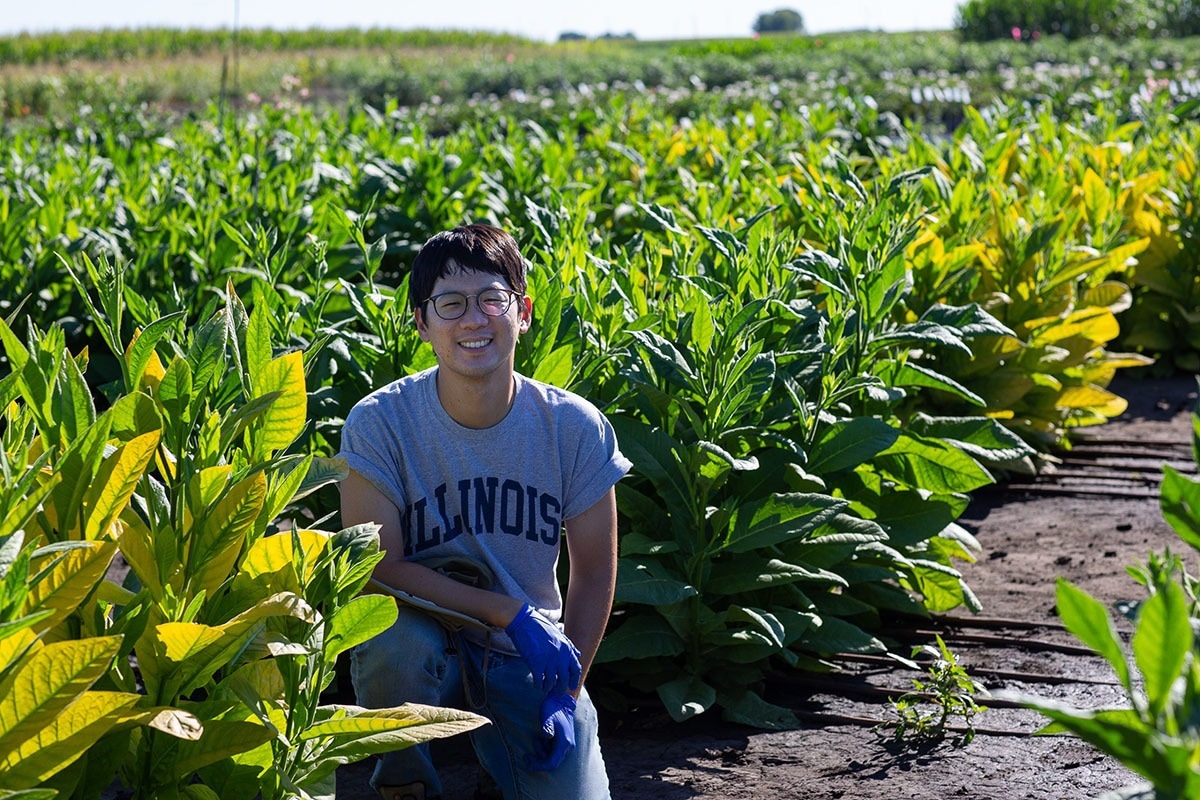Plants have evolved to have high chlorophyll levels in their leaves because chlorophyll is essential to photosynthesis. Creating this pigment is costly, as plants consume a large amount of their available nitrogen to produce chlorophyll and the unique proteins that bind it. Nitrogen is thus unavailable for use in other processes.
 Young Cho used an ethanol spray to reduce the chlorophyll levels in leaves. The spray induced small RNA that interfered with chlorophyll synthesis, resulting in pale yellow plants, and the untreated plants remained completely green. Image Credit: Carl R. Woese Institute for Genomic Biology
Young Cho used an ethanol spray to reduce the chlorophyll levels in leaves. The spray induced small RNA that interfered with chlorophyll synthesis, resulting in pale yellow plants, and the untreated plants remained completely green. Image Credit: Carl R. Woese Institute for Genomic Biology
To determine whether the plant would use the nitrogen it conserved for other processes that would enhance nutritional quality, researchers recently lowered the amount of chlorophyll in leaves.
In an effort to meet the world's food demand, researchers have been working to boost agricultural output during the last few decades. Enhancing the photosynthetic efficiency of agricultural crops has proven to be one of their most significant issues.
One of three things can occur when light strikes a leaf: either the light passes through the leaf or is absorbed by the leaf for photosynthesis. However, a fully green leaf does not use all of the light that strikes it for photosynthesis, even if the leaf absorbs almost 90% of it.
We grow our crop plants at very high densities. As a result, although the leaves at the top of the canopy have more light, they cannot use it all, and the layer below is light-starved; our rationale was to reduce the amount of chlorophyll at the top of the canopy so more light can penetrate and be used more efficiently lower in the canopy.”
Don Ort, Professor, Integrative Biology, Carl R. Woese Institute for Genomic Biology
In the current study, tobacco plants were genetically modified to produce less chlorophyll when the crop canopy grew denser.
Ort noted, “Previous models have shown that if you have lower chlorophyll levels before you have a dense canopy, it is detrimental to plant growth, but we wanted to take plants that have full canopies and ensure that the new leaves that are added on top have lower chlorophyll levels.”
Small RNAs that obstruct crucial stages in chlorophyll production were employed by the researchers to achieve this. The synthesis of these short RNAs was regulated by an inducible promoter, a segment of DNA that reacts to a particular stimulus and instructs the cell to create RNA.
The investigators employed an ethanol-inducible promoter in the investigation. The ethanol they sprayed on the leaves caused tiny RNAs to be produced, which hindered the production of chlorophyll and resulted in a paler shade of green in the canopy.
We found that even when chlorophyll synthesis decreased 70%, there was no inhibition of growth, although we had theoretically predicted this result, observing these pale green or yellow plants growing normally was astonishing, considering that such discoloration typically indicates plant illness.”
Young Cho, Study Lead Author and Postdoctoral Researcher, Carl R. Woese Institute for Genomic Biology
Since less chlorophyll would free up nitrogen that was being used to make the pigment and related proteins, the researchers also reasoned that this would have an impact on other elements of plant growth. Their observations that the plants exhibiting the activation of the ethanol-inducible promoter responsible for the interfering short RNAs had a 17% greater concentration of seed nitrogen proved them correct.
Ort said, “We had also expected an increase in yield because as you get more light into the canopy, you would expect it to be used more efficiently. However, we didn’t detect an increase, which probably means that the plants did not invest enough of the extra nitrogen to improve the photosynthetic capacity in the lower parts of the canopy. This result gives us another engineering target.”
Future research will examine whether light-inducible promoters, which farmers will find more convenient to utilize, can produce comparable outcomes.
Ort observed, “Ethanol-inducible promoters are very convenient and important research tools. However, farmers will not want to spray an entire field with ethanol, so we need to look at other promoters that respond to the intensity or the color of light.”
Source:
Journal reference:
Cho, Y. B., et.al., (2023). Reducing chlorophyll levels in seed‐filling stages results in higher seed nitrogen without impacting canopy carbon assimilation. Plant, Cell & Environment. doi.org/10.1111/pce.14737.